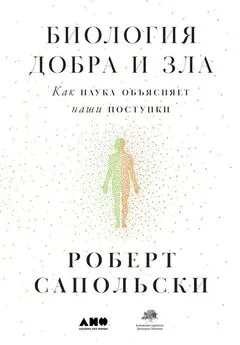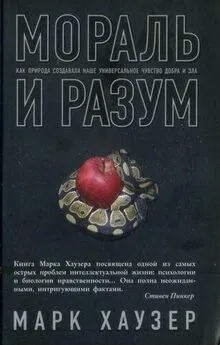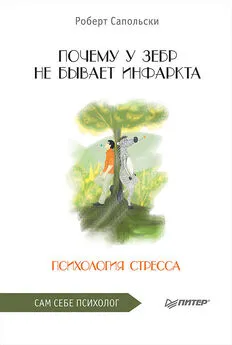Роберт Сапольски - Биология добра и зла. Как наука объясняет наши поступки
- Название:Биология добра и зла. Как наука объясняет наши поступки
- Автор:
- Жанр:
- Издательство:Альпина нон-фикшн
- Год:2019
- Город:Москва
- ISBN:978-5-0013-9051-0
- Рейтинг:
- Избранное:Добавить в избранное
-
Отзывы:
-
Ваша оценка:
Роберт Сапольски - Биология добра и зла. Как наука объясняет наши поступки краткое содержание
Биология добра и зла. Как наука объясняет наши поступки - читать онлайн бесплатно ознакомительный отрывок
Интервал:
Закладка:
353
Reviewed in R. Sapolsky, Why Zebras Don’t Get Ulcers: A Guide to Stress, Stress-Related Diseases and Coping , 3rd ed. (New York: Holt, 2004). Как это происходит у павианов: P. O. Onyango et al., “Persistence of Maternal Effects in Baboons: Mother’s Dominance Rank at Son’s Conception Predicts Stress Hormone Levels in Subadult Males,” Horm Behav 54 (2008): 319.
354
F. L. Woon and D. W. Hedges, “Hippocampal and Amygdala Volumes in Children and Adults with Childhood Maltreatment – Related Posttraumatic Stress Disorder: A Meta-analysis,” Hippocampus 18 (2008): 729; D. Gee et al., “Early Developmental Emergence of Human Amygdala-PFC Connectivity After Maternal Deprivation,” PNAS 110 (2013): 15638; A. K. Olsavsky et al., “Indiscriminate Amygdala Response to Mothers and Strangers After Early Maternal Deprivation,” BP 74 (2013): 853.
355
L. M. Oswald et al., “History of Childhood Adversity Is Positively Associated with Ventral Striatal Dopamine ® Responses to Amphetamine,” Psychopharmacology (Berlin) 23 (2014): 2417; E. Hensleigh and L. M. Pritchard, “Maternal Separation Increases Methamphetamine-Induced Damage in the Striatum in Male, But Not Female Rats,” BBS 295 (2014): 3; A. N. Karkhanis et al., “Social Isolation Rearing Increases Nucleus Accumbens Dopamine and Norepinephrine Responses to Acute Ethanol in Adulthood,” Alcohol: Clin Exp Res 38 (2014): 2770.
356
C. Anacker et al., “Early Life Adversity and the Epigenetic Programming of Hypothalamic-Pituitary-Adrenal Function,” Dialogues in Clin Nsci 16 (2014): 321.
357
S. L. Buka et al., “Youth Exposure to Violence: Prevalence, Risks, and Consequences,” Am J Orthopsychiatry 71 (2001): 298; M. B. Selner-O’Hagan et al., “Assessing Exposure to Violence in Urban Youth,” J Child Psych and Psychiatry 39 (1998): 215; P. T. Sharkey et al., “The Effect of Local Violence on Children’s Attention and Impulse Control,” Am J Public Health 102 (2012): 2287; J. B. Bingenheimer et al., “Firearm Violence Exposure and Serious Violent Behavior,” Sci 308 (2005): 1323. К сноске: I. Shaley et al., “Exposure to Violence During Childhood Is Associated with Telomere Erosion from 5 to 10 Years of Age: A Longitudinal Study,” Mol Psychiatry 18 (2013): 576.
358
Прекрасный развернутый обзор: L. Huesmann and L. Taylor, “The Role of Media Violence in Violent Behavior,” Ann Rev of Public Health 27 (2006): 393. See also J. D. Johnson et al., “Differential Gender Effects of Exposure to Rap Music on African American Adolescents’ Acceptance of Teen Dating Violence,” Sex Roles 33 (1995): 597; J. Johnson et al., “Television Viewing and Aggressive Behavior During Adolescence and Adulthood,” Sci 295 (2002): 2468; J. Savage and C. Yancey, “The Effects of Media Violence Exposure on Criminal Aggression: A Meta-analysis,” Criminal Justice and Behav 35 (2008): 772; C. Anderson et al., “Violent Video Game Effects on Aggression, Empathy, and Prosocial Behavior in Eastern and Western Countries: A Metaanalytic Review,” Psych Bull 136, 151; C. J. Ferguson, “Evidence for Publication Bias in Video Game Violence Effects Literature: A Meta-analytic Review,” Aggression and Violent Behavior 12 (2007): 470; C. Ferguson, “The Good, the Bad and the Ugly: A Meta-analytic Review of Positive and Negative Effects of Violent Video Games,” Psychiatric Quarterly 78 (2007): 309.
359
W. Copeland et al., “Adult Psychiatric Outcomes of Bullying and Being Bullied by Peers in Childhood and Adolescence,” JAMA Psychiatry 70 (2013): 419; S. Woods and E. White, “The Association Between Bullying Behaviour, Arousal Levels and Behaviour Problems,” J Adolescence 28 (2005): 381; D. Jolliffe and D. P. Farrington, “Examining the Relationship Between Low Empathy and Bullying,” Aggressive Behav 32 (2006): 540; G. Gini, “Social Cognition and Moral Cognition in Bullying: What’s Wrong?” Aggressive Behav 32 (2006): 528; S. Shakoor et al., “A Prospective Longitudinal Study of Children’s Theory of Mind and Adolescent Involvement in Bullying,” J Child Psych and Psychiatry 53 (2012): 254.
360
J. D. Unenever, “Bullies, Aggressive Victims, and Victims: Are They Distinct Groups?” Aggressive Behav 31 (2005): 153; D. P. Farrington and M. M. Tofi, “Bullying as a Predictor of Offending, Violence and Later Life Outcomes,” Criminal Behaviour and Mental Health 21 (2011): 90; M. Tofi et al., “The Predictive Efficiency of School Bullying Versus Later Offending: A Systematic/ Meta-analytic Review of Longitudinal Studies,” Criminal Behaviour and Mental Health 21 (2011): 80; T. R. Nansel et al., “Cross-National Consistency in the Relationship Between Bullying Behaviors and Psychosocial Adjustment,” Arch Pediatrics & Adolescent Med 158 (2004): 730; J. A. Stein et al., “Adolescent Male Bullies, Victims, and Bully-Victims: A Comparison of Psychosocial and Behavioral Characteristics,” J Pediatric Psych 32 (2007): 273; P. W. Jansen et al., “Prevalence of Bullying and Victimization Among Children in Early Elementary School: Do Family and School Neighbourhood Socioeconomic Status Matter?” BMC Public Health 12 (2012): 494; A. Sourander et al., “What Is the Early Adulthood Outcome of Boys Who Bully or Are Bullied in Childhood? The Finnish ‘From a Boy to a Man’ Study,” Pediatrics 120 (August 2007): 397; A. Sourander et al., “Childhood Bullies and Victims and Their Risk of Criminality in Late Adolescence,” Arch Pediatrics & Adolescent Med 161 (2007): 546; C. Winsper et al., “Involvement in Bullying and Suicide-Related Behavior at 11 Years: A Prospective Birth Cohort Study,” J the Am Academy of Child and Adolescent Psychiatry 51 (2012): 271; F. Elgar et al., “Income Inequality and School Bullying: Multilevel Study of Adolescents in 37 Countries,” J Adolescent Health 45 (2009): 351.
361
G. M. Glew et al., “Bullying, Psychosocial Adjustment, and Academic Performance in Elementary School,” Arch Pediatrics & Adolescent Med 159 (2005): 1026.
362
K. Appleyard et al., “When More Is Not Better: The Role of Cumulative Risk in Child Behavior Outcomes,” J Child Psych and Psychiatry 46 (2005): 235.
363
M. Sheridan et al., “Variation in Neural Development as a Result of Exposure to Institutionalization Early in Childhood,” PNAS 109 (2012): 12927; M. Carlson and F. Earis, “Psychological and Neuroendocrinological Sequelae of Early Social Deprivation in Institutionalized Children in Romania,” ANYAS 15 (1997): 419; N. Tottenham, “Human Amygdala Development in the Absence of Species-Expected Caregiving,” Developmental Psychobiology 54 (2012): 598; M. A. Mehta et al., “Amygdala, Hippocampal and Corpus Callosum Size Following Severe Early Institutional Deprivation: The English and Romanian Adoptees Study Pilot,” J Child Psych and Psychiatry 50 (2009): 943; N. Tottenham et al., “Prolonged Institutional Rearing Is Associated with Atypically Large Amygdala Volume and Difficulties in Emotion Regulation,” Developmental Sci 13 (2010): 46; M. M. Loman et al., “The Effect of Early Deprivation on Executive Attention in Middle Childhood,” J Child Psych and Psychiatry 54 (2012): 37; T. Eluvathingal et al., “Abnormal Brain Connectivity in Children After Early Severe Socioemotional Deprivation: A Diffusion Tensor Imaging Study,” Pediatrics 117 (2006): 2093; H. T. Chugani et al., “Local Brain Functional Activity Following Early Deprivation: A Study of Postinstitutionalized Romanian Orphans,” Neuroimage 14 (2001): 1290.
364
Ее идеи изящно подытожены в работе: M. Small, Our Babies, Ourselves (New York: Anchor Books, 1999).
365
H. Arendt, The Origins of Totalitarianism (New York: Harcourt 1951); T. Adorno et al., The Authoritarian Personality (New York: Harper & Row, 1950).
366
D. Baumrind, “Child Care Practices Anteceding Three Patterns of Preschool Behavior,” Genetic Psych Monographs 75 (1967): 43.
367
E. E. Maccoby and J. A. Martin, “Socialization in the Context of the Family: Parent-Child Interaction,” in Handbook of Child Psychology , ed. P. Mussen (New York: Wiley, 1983).
368
J. R. Harris, The Nurture Assumption: Why Children Turn Out the Way They Do (New York: Simon & Schuster, 1998).
369
J. Huizinga, Homo Ludens: A Study of the Play-Element in Culture (London: Routledge & Kegan Paul, 1938); A. Berghänel et al., “Locomotor Play Drives Motor Skill Acquisition at the Expense of Growth: A Life History Trade-off,” Sci Advances 1 (2015): 1; J. Panksepp and W. W. Beatty, “Social Deprivation and Play in Rats,” Behav and Neural Biol 39 (1980): 197; M. Bekoff and J. A. Byers, Animal Play: Evolutionary, Comparative, and Ecological Perspectives (Cambridge: Cambridge University Press, 1998); M. Spinka et al., “Mammalian Play: Training for the Unexpected,” Quarterly Rev of Biol 76 (2001): 141.
370
S. M. Pellis, “Sex Differences in Play Fighting Revisited: Traditional and Nontraditional Mechanisms of Sexual Differentiation in Rats,” Arch Sexual Behav 31 (2002): 17; B. Knutson et al., “Ultrasonic Vocalizations as Indices of Affective States in Rats,” Psych Bull 128 (2002): 961; Y. Delville et al., “Development of Aggression,” in Biology of Aggression , ed. R. Nelson (Oxford: Oxford University Press, 2005).
371
J. Tsai, “Ideal Affect: Cultural Causes and Behavioral Consequences,” Perspectives on Psych Sci 2 (2007): 242; S. Kitayama and A. Uskul, “Culture, Mind, and the Brain: Current Evidence and Future Directions,” Ann Rev of Psych 62 (2011): 419.
372
C. Kobayashi et al., “Cultural and Linguistic Influence on Neural Bases of ‘Theory of Mind’: An fMRI Study with Japanese Bilinguals,” Brain and Language 98 (2006): 210; C. Lewis et al., “Social Influences on False Belief Access: Specific Sibling Influences or General Apprenticeship?” Child Development 67 (1996): 2930; J. Perner et al., “Theory of Mind Is Contagious: You Catch It from Your Sibs,” Child Development 65 (1994): 1228; D. Liu et al., “Theory of Mind Development in Chinese Children: A Meta-analysis of False-Belief Understanding Across Cultures and Languages,” Developmental Psych 44 (2008): 523.
373
C. Anderson et al., “Violent Video Game Effects on Aggression, Empathy, and Prosocial Behavior in Eastern and Western Countries: A Meta-analytic Review,” Psych Bull 136 (2010): 151.
374
R. E. Nisbett and D. Cohen, Culture of Honor: The Psychology of Violence in the South (Boulder, CO: Westview Press, 1996).
Читать дальшеИнтервал:
Закладка:





![Роберт Сапольски - Игры тестостерона и другие вопросы биологии поведения [litres]](/books/1074102/robert-sapolski-igry-testosterona-i-drugie-vopros.webp)




